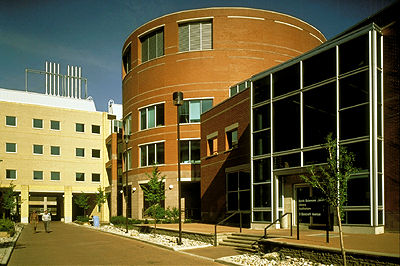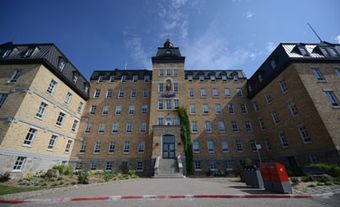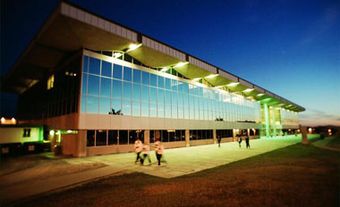The University of Toronto is Canada’s largest university. Situated in present-day Toronto, its origins go back as far as 1827. Over the course of its history, the university has trained many famous Canadian personalities. Today, the university has more than 93,000 students studying in over 80 departments.
History
What would become the University of Toronto (U of T) was founded as King's College by royal charter in 1827. The College was initially controlled by the colonial establishment and the Church of England. The church affiliation made it unpopular however. Consequently, in 1849, the institution was secularized, and, in 1850, became the nondenominational University of Toronto. The Anglicans responded by creating Trinity College in Toronto in 1851 (actually opening in 1852).
In the 1850s the University of Toronto was reorganized and University College was created as its teaching arm. Structural changes encouraged other denominational colleges to federate with U of T: Victoria College (Methodist, founded 1841 in Cobourg) and St Michael's College (Roman Catholic, founded 1852 in Toronto by the Basilian Order) joined in 1890 and Trinity College in 1904. Each of them retained their university status to continue granting degrees in theology. During this period some of Toronto's theological colleges also federated with the university. Knox College (founded 1844), originally a Presbyterian seminary, affiliated with the university in 1885 and federated in 1890. Wycliffe College (Anglican, founded 1877) became a federated college in 1889. Emmanuel College (Methodist, founded 1836) became affiliated with the university as a United Church of Canada seminary in 1925, the year the United Church came into existence.
Programs
The reorganization of U of T in the 1850s resulted in the abolishment of the faculties of law and medicine, but these were restored in 1887. The Royal College of Dental Surgeons (founded 1875) was affiliated with the university from 1888 until 1925, when it became the Faculty of Dentistry. Engineering students attended the School of Practical Science, which was affiliated with the university from its inception in 1878 until 1887, when it amalgamated. The Conservatory of Music became an affiliate in 1896.
After the turn of the century the university expanded rapidly. New faculties included home economics (1906), education (1907), forestry (1907), social work (1914), nursing (1920), graduate studies (1922), hygiene (1926) and the School of Architecture (1948).
In 1969, the Toronto School of Theology (TST) was created as an independent federation of seven schools of theology, including the divinity faculties of Victoria (Emmanuel), St Michael's and Trinity universities and Knox and Wycliffe colleges. Within its own federation, U of T granted all but theology or divinity degrees. However, since 1978, the university has granted theology degrees conjointly with TST's member institutions.
Today, the School of Graduate Studies at the U of T houses over 80 graduate departments. They represent a broad array of fields from theoretical astrophysics to medieval studies, with more recent arrivals being museum studies and knowledge media design.
Research Infrastructure
Canada's evolution was reflected in the growth and diversification of the university. The University of Toronto Press was established in 1901 and became a full-scale academic publishing house after 1945. By 1988, it was publishing 88 titles and 25 periodicals a year. (See University Presses). Today the U of T Press releases approximately 140 new scholarly, reference and general-interest books annually, including the renowned reference titles Canadian Who's Who and Canadian Books in Print.
Affiliate research institutions such as the Royal Ontario Museum (1914), Connaught Medical Laboratories (1914) and the David Dunlap Observatory (1935) played an important role in the development of the university. The building program during this period included Hart House, a social, cultural and recreational centre that was built between 1911 and 1919 and given to the university in 1919 by Vincent Massey.
Graduate institutes in various areas of specialization were developed, the first being the Institute of Business Administration (1958). The Ontario Institute for Studies in Education (OISE) was founded in 1965 as a research and development institute and as a graduate school of education. In 1996 OISE and U of Ts Faculty of Education were integrated to form OISE/UT.
Decentralization
The need to decentralize the university to meet the needs of metropolitan Toronto's growing population led to the development of 2 suburban campuses. Scarborough College, now U of T Scarborough, was first built in 1964 and then Erindale College, now U of T Mississauga, in 1966. The undergraduate college system was expanded at the central campus to include New College (1962) and Innis College (1964). Massey College, the only college solely for graduates in U of T, was built and furnished by the Massey Foundation. It opened in 1963 with Robertson Davies as its founding master. York University was affiliated with the University of Toronto from its creation in 1959 until it became fully independent in 1965.
Influence
U of T has made important contributions in many areas of scholarship and research. The discovery of insulin and stem cells as well as the development of Pablum and liquid helium took place at the University. The university’s research also led to the creation of an artificial pancreas, the genes for cystic fibrosis and the most severe form of Alzheimer's disease. The laser-beam image recorder was also developed at U of T. Moreover, the university is the home of many research projects in the arts and humanities, including the Dictionary of Canadian Biography, Records of Early English Drama, the Dictionary of Old English, and the editing of the works of John Stuart Mill.
Noted alumni include authors such as Margaret Atwood, Farley Mowat and Michael Ondaatje. Humorist Stephen Leacock as well as actors Donald Sutherland, Raymond Massey and Don Harron also graduated from U of T. Film directors Arthur Hiller, Atom Egoyan, David Cronenberg and Norman Jewison alongside media personalities Peter Gzowski and Barbara Barbara Amiel come from the university. The opera singers Teresa Stratus and Maureen Forrester likewise graduated from U of T. The astronaut Roberta Bondar completed her neuroscience PhD at U of T. Notable engineers include Elsie MacGill who was, in fact, the first woman to enroll in engineering at the U of T.
Many political figures studied and graduated at the U of T. These include former prime ministers William Lyon Mackenzie, Arthur Meighen and Lester Pearson. Governor General Adrienne Clarkson graduated in English Literature from the university.
In 2019–2020, there were over 93,000 students enrolled at the U of T.

 Share on Facebook
Share on Facebook Share on X
Share on X Share by Email
Share by Email Share on Google Classroom
Share on Google Classroom






